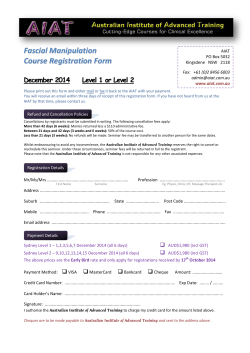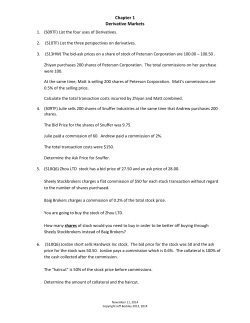
Your asset allocation guide – March 2015
Your Asset Allocation Guide During February, the German government issued €3.3 billion of five-year bonds at a yield of -0.08%; the first time ever that they have sold five-year bonds at negative rate. This means investors are paying the German government to look after their money for five years. And French company GDF Suez recently issued two-year zero –coupon bonds that will return just 0.13% per annum, when redeemed. So, on the one hand we have bond yields at or near record lows in many parts of the world and at the same time share markets in the United States and Germany are hitting fresh record highs, reflecting future revenue growth and earnings that may never materialise. Certainly equity markets valuations appear stretched when looking at historical levels, although they don’t look too bad when we assume a long period of cash and bond yields which remain near zero. So where should marginal investment dollars be directed? Some investors may benefit from looking outside the usual areas. For example, so called “frontier” equity markets and selected emerging markets where valuations are more reasonable are one idea. Or, investors could consider out-of-favour stocks and sectors (for example energy shares that may have been oversold), second tier commercial real estate (examples include regional offices and supermarkets) and alternative “beta” or risk premium strategies which are investment strategies which may generate returns over longer time horizons and which don’t need markets to move higher. Alternative strategies include opportunities like catastrophe bonds, market or single stock trend-following, put and call option writing, currency-carry trades. Investors could also consider equity market neutral strategies that can hopefully make money in rising and falling equity markets such as buying value shares and short-selling growth shares or buying low volatility shares and short selling high volatility shares. All this means that investors cannot simply rely on equity and bond markets to move higher. They need to seek out a range of alternate strategies and out of favour sectors which are not necessarily attracting large amounts of cheap capital in the current environment. By Nick Ryder, NAB Private Wealth Investment Strategist Asset allocation summary Asset Class View Comments Cash + • Fixed Income + • • • • • Australian Equities – International Equities N Alternatives N • • • • • • • • • • Property N • • Hold an overweight position in cash to be able to take advantage of new opportunities when they arise e.g. a sell-off in equities We suggest shorter maturity term deposits over at-call cash We suggest an overweight position in fixed income Developed world government bonds are very expensive and offer poor absolute value, so prefer products with limited interest rate risk We suggest an equal split between Australian and (hedged) international bonds Tactical income, absolute return fixed income strategies, floating-rate corporate securities and short duration fixed income are all preferred over benchmark-aware bond strategies Remain underweight Growth outlook is lower than other markets and valuations are above fair value Favour selective industrials (I.e. offshore earners) Hold positions in quality smaller companies but do not add Given higher valuations in developed market shares, hold a neutral weighting Maintain unhedged currency exposure for now Emerging markets are cheaper than developed markets so maintain direct exposure, or indirectly through the emerging markets earnings of global companies Maintain a neutral allocation until opportunities emerge Returns and risk in the alternative investments sector have been dialled back in recent years reflecting lower volatility and more conservatism by managers Alternatives as part of an overall strategy of building allocations to assets with low/moderate correlation to equities Hold a neutral allocation to commercial property. Demand for core property is robust as larger investors seek to buy real assets with attractive rental yields At current pricing, Australian and international property appears fair value About our recommendations The asset allocation recommendations reflect NAB Private Wealth’s views on the relative attractiveness of the asset class over a 1–3 year holding period. A neutral allocation (orange) means hold a neutral strategic allocation to the asset class, single minus underweight (orange) or single plus overweight (light green) recommendations are meant to rebalance the asset class progressively towards the bottom or top of your strategic asset allocation range using cashflows inflows or outflows to the portfolio. A double plus overweight (dark green) or double minus underweight (red) recommendation is intended to be rebalanced to the top end or bottom end of your strategic asset allocation range immediately by selling some assets and buying others. NAB Private View – March 2015 1 Asset allocation Australian Equities Fixed Income Alternatives The S&P/ASX 200 Accumulation Index rose 6.9% in February as many companies reported half yearly earnings which were, on the whole, broadly in line with expectations. The materials sector rose 11.7% led by BHP and Rio Tinto shares. Telecommunications and consumer staples fell due to declines in Telstra and Woolworths shares while smaller companies outperformed larger stocks with a rise of 8.2%. Australian bonds posted a return of 0.3% in February. Three-year Australian government bond yields fell another 18 basis points to new lows of 1.80% per annum, while 10-year yields held steady at 2.47% per annum. Hedge funds posted their best monthly return since December 2010 in February with gains of 2.0%. This month it was funds investing in takeover and merger stocks that performed the best, while trend-following strategies made a small loss, the first since July 2014. We still favour selective industrials, infrastructure, healthcare, consumer discretionary and diversified financials and are underweight the banking sector. The market is currently trading on 16.1 times forecast earnings, however, forecasts have been adjusted down in the past month after the results season. We suggest: Remain underweight. Valuations are at slightly above fair value and attractive growth or value opportunities are scarce. International Equities Global equities returned 5.9% in February in local currency terms. European stocks continued to rise after the ECB’s January stimulus announcement and aversion of a potential Greek debt default. The US market hit new highs despite some mixed earnings reports. In US Dollar terms emerging markets rose 3.3%. Markets are trading above fair value driven higher by zero or negative interest rates in many markets which is forcing investors into riskier, higher yielding assets such as shares. In many cases equity markets are pricing in growth which may be unlikely to materialise in the short to medium term. We suggest: Given higher valuations for developed market shares, maintain a neutral (unhedged currency) exposure to international shares. Favour US over Europe. Maintain exposure to emerging markets shares. NAB Private View – March 2015 Internationally, the Citi World Broad Investment Grade index returned 1.0%. With the rise in equities, corporate credit spreads contracted. US high yield bonds fell from a spread of 537 basis points over US treasury bonds to a margin of 443 basis points in February. We suggest: Overweight overall exposure to fixed income with an equal split between Australian and international bonds. Stay underweight longer term government and corporate bonds. Prefer tactical income and absolute return fixed income strategies. Cash Australian bank bills returned 0.21% in February as three-month bank bill yields fell from 2.53% to 2.33% per annum due to the rate cut in early February. At the March RBA Board meeting official interest rates were left on hold. The RBA appears willing to cut rates further in coming months, if needed. Economists and financial markets continue to forecast further rate cuts in 2015, which is being reflected in shorter term bond yields and term deposits which is forcing investors into riskier assets in the search for yield. NAB economists expect one more 25 basis point rate cut in May (to 2.0% per annum) before a period of stability. We suggest: Retain an overweight position. As other assets become expensive cash provides flexibility to buy other assets on a price pullback. Bank term deposits preferred relative to government bonds and at-call cash. The pick-up in volatility and trending markets should assist certain hedge fund strategies (such as macro and trend following strategies) in coming months, however, bottom-up individual manager selection is more likely to provide better returns than top-down strategy selection. We suggest: Maintain a neutral position. Manager selection remains more important than strategy selection. Liquid alternative investments including hedge funds remain favoured for incremental risk exposures. Property Returns from unlisted Australian core property funds were 9.3% in the 12 months to the end of January 2015. Average distribution yields range from 5.2% for retail property, 6.0% for offices and 7.7% for industrial property. In the listed property market, REIT indices underperformed broader share market indices in February with returns of +2.9% in Australia and -0.6% globally. Sentiment and capital flows are still favourable for commercial property, with the lower interest rate environment helping support investor demand which is pushing yields lower. Australian commercial property is benefiting from investor interest out of Asia. In some international markets, property valuations are expensive, but in others they appear at around fair value. We suggest: Remain neutral For listed property exposures, reduce Australian exposure and increase weighting to international property securities. By Nick Ryder, NAB Private Wealth Investment Strategist 2
© Copyright 2025













